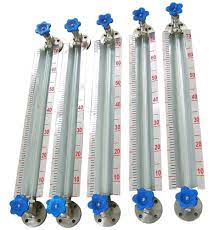Get In Touch
Get In Touch




Description:
A level indicator is a simple yet crucial device used to measure and display the level of a substance, such as liquid or granular materials, in a container or tank. It typically consists of a transparent tube or gauge with markings that indicate the substance's height or volume. As the substance fills or empties the container, the indicator provides a visual reference, allowing users to monitor and maintain the desired level. Level indicators find widespread applications in industries such as agriculture, manufacturing, and chemical processing, ensuring efficient management of materials and preventing overflows or shortages.
Device Type: Float Operated Level Indicator
Measuring Principle: Buoyancy-based (float rises or falls with the liquid level)
Material: Typically made of corrosion-resistant materials like stainless steel, PVC, or acrylic
Measuring Range: Determined by the length of the indicator tube or cable
Accuracy: Generally within ±2% of full scale
Mounting Type: Top-mounted or side-mounted
Operating Temperature Range: -20°C to 100°C (-4°F to 212°F) for standard materials
Pressure Range: Atmospheric pressure for most applications
Output: Visual indication through markings on the tube or electronic signal output (4-20 mA, 0-10 V) for automated systems
Protection: May include options for explosion-proof or weatherproof enclosures
Process Connection: Threads, flanges, or other options for tank or pipeline attachment
Float Design: Varies depending on the type of liquid (e.g., magnetic float for non-contact level measurement)
Optional Features: High/low-level alarms, remote monitoring, communication interfaces (HART, Modbus, etc.),and additional safety features as required
Power Supply: For electronic indicators, typically 24V DC or 110-240V AC
Certifications: May comply with industry-specific standards and regulations (e.g., ATEX, CSA, CE)
1. Industrial Tanks: Level indicators are commonly used in industrial settings to monitor the levels of liquids, such as chemicals, oil, or water, in storage tanks. They help prevent overflows and underflows, ensuring the efficient use of resources and safe operations.
2. Water Treatment Plants: Level indicators play a crucial role in water treatment facilities by monitoring the levels of various treatment chemicals, ensuring accurate dosing and maintaining water quality standards.
3. Agriculture: In agriculture, level indicators are used to monitor the levels of fertilizers, pesticides, and irrigation water in tanks and storage containers. This helps farmers manage resources effectively and avoid over-application.
4. Pharmaceuticals: In pharmaceutical manufacturing, precise control of liquid levels is essential for accurate mixing and formulation. Level indicators help maintain quality and consistency in drug production.
5. Food and Beverage: Level indicators are used in the food and beverage industry to control the levels of ingredients, such as liquids, syrups, and flavorings, in processing and mixing tanks, ensuring consistent product quality.
6. Petroleum Industry: Petroleum storage tanks employ level indicators to monitor the levels of crude oil, gasoline, and other products, helping to prevent spillage and ensure compliance with environmental regulations.
7. Chemical Processing: Chemical plants use level indicators for both safety and operational efficiency, as they help avoid spills, maintain accurate mixing ratios, and control the flow of chemicals in various processes.
8. Marine Applications: Level indicators are essential on ships and boats to monitor fuel and water levels in tanks, ensuring safe navigation and efficient use of resources during long journeys.
9. Wastewater Management: In wastewater treatment facilities, level indicators are used to monitor the levels of sewage, sludge, and other materials, helping in the proper management of treatment processes.
10. Mining and Mineral Processing: Level indicators are utilized in mining and mineral processing operations to monitor levels of ore, slurry, and chemicals, optimizing the extraction and separation processes.
11. HVAC Systems: In heating, ventilation, and air conditioning systems, level indicators control the water or coolant levels in cooling towers and reservoirs, ensuring efficient temperature regulation.
12. Renewable Energy: Level indicators are used in solar water heaters and geothermal energy systems to monitor and maintain the fluid levels in heat exchange systems.


